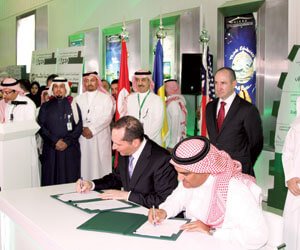News & Events
-
Taqnia Space > Blog > News & Events > TAQNIA SPACE Partners with DigitalGlobe and KACST to Develop Constellation of Small Imaging Satellites
25May
TAQNIA SPACE Partners with DigitalGlobe and KACST to Develop Constellation of Small Imaging Satellites
by admin, 0 Comments

TAQNIA SPACE and KACST and DigitalGlobe signed an agreement on February 21, 2016, to form a joint venture that will be responsible for developing six or more sub-meter resolution imaging satellites. The small satellites are expected to be capable of collecting imagery with anticipated 80 cm resolution and will leverage DigitalGlobe’s industry-leading ground infrastructure. TAQNIA SPACE and KACST will benefit from DigitalGlobe’s imagery production platform and expertise and massive catalog of high-resolution, high-accuracy imagery, which will improve the native accuracy of the small satellite imagery. TAQNIA SPACE and KACST will also benefit from DigitalGlobe’s global distribution capability and existing customer relationships with the world’s largest buyers of commercial satellite imagery and geospatial information.
KACST will construct, integrate, and launch the satellites, and it will own 50% of the satellites’ imaging capacity inside of KACST’s communication cone, which includes Saudi Arabia and the surrounding region. DigitalGlobe will have rights to the other 50% of the capacity inside this region and 100% of the satellites’ capacity outside of the region. TAQNIA SPACE will be responsible for marketing and monetizing 50% of the capacity within the KACST communication cone. DigitalGlobe will be responsible for marketing and monetizing the remaining 50% of capacity within the KACST communication cone and 100% of the remaining worldwide capacity. Additionally, DigitalGlobe, TAQNIA SPACE, and KACST will share the commercially generated revenue. The small satellites are expected to be launched in late 2018 or early 2019 and will be highly complementary to the next-generation satellite architecture DigitalGlobe is developing to replenish WorldView-1 and WorldView-2. Finally, this partnership offers DigitalGlobe customers a complementary source of data to address new use cases, while expanding the image catalog of DigitalGlobe’s Geospatial Big Data platform.
“The satellites developed under this partnership will allow us to uniquely unlock new value in emerging use cases by combining high-resolution, high-accuracy imagery and high-revisit imagery,” said Jeffrey R. Tarr, DigitalGlobe President and Chief Executive Officer. “This innovative, capital-efficient business model leverages DigitalGlobe’s extensive investment in an industry-leading ground infrastructure and our customer relationships to the mutual benefit of both parties. We are proud to expand our strong partnership with H.H. Dr. Turki and the Kingdom of Saudi Arabia.”
“Partnering with the premier commercial satellite imaging firm will help to propel the Kingdom of Saudi Arabia to become a leader in remote sensing and satellite technology,” said H.H. Dr. Turki bin Saud, Chairman of the Board of Directors for TAQNIA SPACE and President of KACST.
“We believe this partnership has tremendous value for TAQNIA SPACE, DigitalGlobe, and the many global customers that will be able to leverage these unique capabilities,” said Mr. Abdullah Alosaimi, Chief Executive Officer of TAQNIA SPACE Company.

Saleh bin Nasser Al-Jasser, Director General of Saudia, said “it is amazing to see the ideas that have been presented and developed throughout the course of this program. Many of these concepts have the potential to change the aviation industry, and witnessing these innovations come from the youth in Saudi Arabia has opened doors, advancements and opportunities for the young talent and Saudia, as the national carrier of the Kingdom.”
Following the awarding of the winners, community partnersand , elaborated on the future of the winning ideas as they enter the incubation process.
- Aviation Australia Riyadh College, the Saudi Arabian Cultural Mission (SACM)
- Qotuf, Saudi’s leading think-tank incubation firm
- Aviation Australia Riyadh College, the Saudi Arabian Cultural Mission (SACM)
Elaborated on the future of the winning ideas as they enter the incubation process. Other winning submissions focused on the contribution to the safety of passengers starting from the runway using Mohamad Ghulam’s technology solution that deals with foreign object debris, to Rehab Aljuhni and Raed Alrefaei’s contribution to inflight safety and comfort of passengers who suffer from low blood pressure and require movement during long-haul flights.
These environmentally controlled sites are designed to provide secure managed and unmanaged rack space, with access to redundant backbone connectivity, together with antenna facilities for uplinking and downlinking to several satellite positions.
Satellite offers extensive monitoring solutions and provides 24 / 7 network operations, on-site support, management and operational resilience of its IP ground-based solutions
